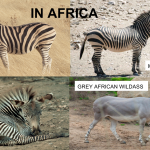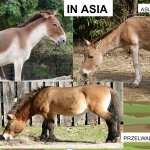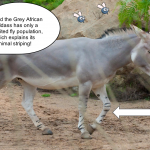Contributed by Isaac Cohen, Spencer Fogelman and Moira Sullivan
Simply click on the first image and click through the gallery to be taken on an epic journey with Dave the Detective as he finds out why zebras have stripes!
Zebra’s stripes have puzzled biologists for centuries. Out of the seven living species of the horse family, three have stripes and four do not. For the three with stripes, the striping degree varies. Five hypotheses have been proposed for their occurrence: (1) camouflage, (2) predator avoidance, (3) heat management, (4) ability to recognize other zebras, and (5) repelling biting flies. First researchers compared the degree of striping in zebra species with the prevalence of woodland habitats, and saw no association. Then researchers compared the degree of striping with the prevalence of larger predators (lions, tigers, wolves, and hyenas) and saw no association. Next researchers compared the degree of striping with maximum temperatures in habitats and saw no association. Then researchers compared the degree of striping with the size of zebra herds and saw no association. Finally, researchers compared the degree of striping with the prevalence of biting flies, such as tabanid flies and tsetse flies. Researchers found that the more prevalent these biting flies are, the more pronounced the stripe pattern was in zebras. To corroborate this evidence they saw that these biting fly species avoided striped surfaces. This suggests that natural selection favored zebras with striping pattern because they repelled biting flies that spread diseases. Other animals don’t need this striping pattern because they have thicker fur than that of zebras that can protect them.
For more information, see:
Adam Egri, Miklos Blaho, et al. 2011. Polarotactic tabanids find striped patterns with brightness and/or polarization modulation least attractive: an advantage of zebra stripes. The Journal of Experimental Biology 215, 736-745.
L. Mollwo. 1983. Interpretation of patterns of drifting Zebra stripes. Solar Physics 83: 305-320.
Tim Caro et al. 2014. The function of zebra stripes. Nature Communications. 5: 3535.
D. Godfrey et al. 1987. Zebra stripes and tiger stripes: the special frequency distribution of the pattern compared to that of the background is significant in display and crypsis. Biological Journal of the Linnean Society: 32: 427-433.
Gyorgy Kriska et al. 2009. Degrees of polarization of reflected light eliciting polarotaxis in dragonflies (Odonata), mayflied (Ephemeroptera) and tabanid flies (Tabanidae). Journal of Insect Physiology. 55:1167-1173.
Ohshima K, Okada K, et all. 1981. Evidence on horizontal transmission of bovine leukemia virus due to blood-sucking tabanid flies.



















